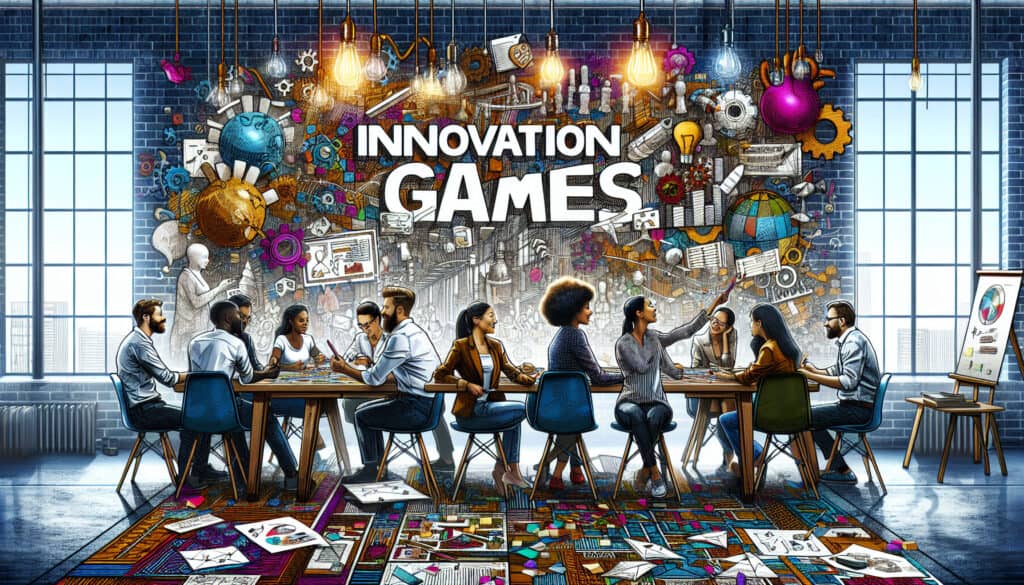A set of collaborative exercises for understanding customer needs and designing new products.
- Methodologien: Kunden & Marketing, Ideenfindung, Produktdesign
Innovation Spiele

Innovation Spiele
- Agile Methodik, Kundenerfahrung, Customer Journey Mapping, Design Denken, Innovation, Marktforschung, Prototyping, Benutzererfahrung (UX), Benutzerzentriertes Design
Zielsetzung:
Wie es verwendet wird:
- A collection of qualitative research methods that use games to help customers articulate their needs and desires. These games are designed to be more engaging and insightful than traditional market research techniques.
Vorteile
- Provides deep insights into customer needs; Can be more engaging and fun than traditional research methods.
Nachteile
- Can be time-consuming and expensive to conduct; Requires a skilled facilitator.
Kategorien:
- Kunden & Marketing, Produktdesign
Am besten geeignet für:
- Understanding customer needs and designing new products and services in a collaborative and engaging way.
Innovation Games can be particularly beneficial in sectors such as technology, consumer goods, healthcare, and automotive industries, where understanding user requirements is pivotal for product development. These engaging methodologies can be utilized in various project phases, notably during ideation and concept validation, often following traditional research approaches to enrich the data collected. Sessions typically involve cross-functional teams, including product designers, engineers, marketers, and actual customers, who collaborate to shape product concepts based on real-world feedback. Specific game formats, such as “Product Box” or “Empathy Mapping,” encourage participants to express their thoughts creatively, allowing for a deeper exploration of desires and pain points beyond surface-level responses. These sessions can be facilitated in workshops, design sprints, or focus groups, making them adaptable to different organizational cultures. Furthermore, the playful nature of these games can reduce the pressure participants often feel during conventional interviews, leading to more authentic and candid responses. The combination of fun and structured activities generates a rich tapestry of qualitative data, ultimately contributing to more innovative and customer-centric product solutions.
Die wichtigsten Schritte dieser Methodik
- Choose a specific game type appropriate for the research goal.
- Facilitate the game, ensuring participants understand the rules and objectives.
- Encourage open dialogue among participants during gameplay.
- Observe interactions and note emerging themes and ideas.
- Capture visual and verbal outputs generated during the game.
- Debrief with participants to explore deeper meanings behind their contributions.
- Identify patterns and clusters from the collected outputs.
- Translate findings into actionable product or service concepts.
Profi-Tipps
- Incorporate role-playing elements into games to create realistic scenarios that reveal deeper motivations and pain points around product usage.
- Utilize mixed methods within Innovation Games, combining qualitative data from game results with quantitative data from traditional research for well-rounded analysis.
- Encourage collaborative brainstorming sessions post-game to synthesize findings and directly engagieren participants in prioritizing their needs and desires.
Verschiedene Methoden lesen und vergleichen, Wir empfehlen die
> Umfassendes Methoden-Repository <
zusammen mit den über 400 anderen Methoden.
Ihre Kommentare zu dieser Methodik oder zusätzliche Informationen sind willkommen auf der Kommentarbereich unten ↓ , sowie alle ingenieursbezogenen Ideen oder Links.
Historischer Kontext
1949
1950
1950
1960
1960
1960
1960
1940
1950
1950
1958
1960
1960
1960
1960
(wenn das Datum nicht bekannt oder nicht relevant ist, z. B. "Strömungsmechanik", wird eine gerundete Schätzung des bemerkenswerten Erscheinens angegeben)















Verwandte Artikel
Fragebögen zu muskuloskelettalen Beschwerden
Multivariate Tests (MVT)
Mehrfache Regressionsanalyse
Motion-Capture-Systeme
MoSCoW-Methode
Moods Median-Test